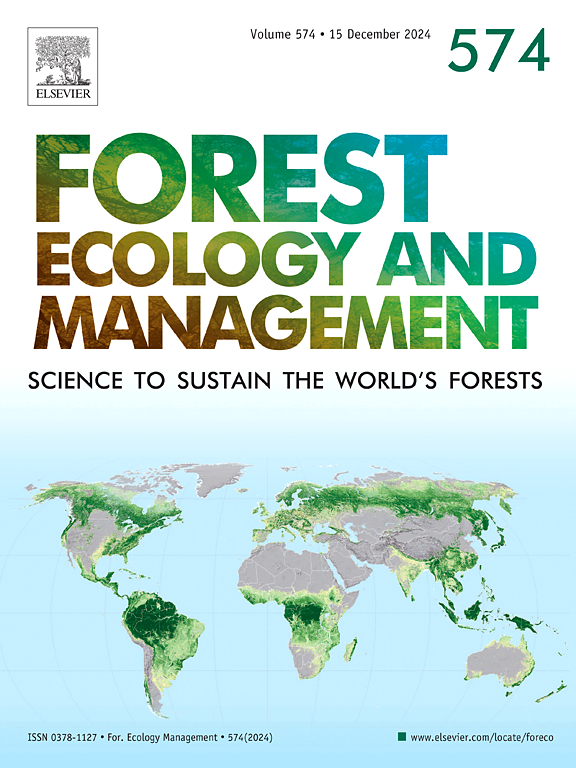Modeling regional forest site productivity accounting spatial structure in climatic and edaphic variables
IF 3.7
2区 农林科学
Q1 FORESTRY
引用次数: 0
Abstract
With increasing interest in sustaining productivity amid changing climate, disturbance regimes, and management practices, an accurate forest productivity estimate is important to develop sustainable management regimes. Our goal was to estimate and map the potential productivity of co-occurring tree species. We used forest inventory and analysis (FIA) data and climatic and edaphic variables to model the composite site index (CSI) as a proxy of potential forest productivity. Initially, we identified the site index model for selected species: slash pine (Pinus elliottii), longleaf pine (Pinus palustris), loblolly pine (Pinus taeda), and yellow poplar (Liriodendron tulipifera). We then standardized species-specific site index (SI) values to generate composite site index (CSI) values. Finally, we used a random forest (RF) machine learning algorithm (ML) to predict CSI values based on climatic and edaphic factors while addressing spatial dependencies in the data set. The RF model explained 81 % of the variation (R2adj = 0.81), with a mean bias of 0.11 m and a mean absolute error (MAE) of 3.37 m. The accuracy of modeling and mapping forest productivity using CSI depends on the quality and spatial distribution of national forest inventory data at the species level and climatic information. We recommend modeling forest productivity that accounts for spatial structure in the data to reduce overinflation of overall accuracy.
区域林地生产力建模:气候和土壤变量的空间结构核算
随着人们对在不断变化的气候、干扰机制和管理实践中维持生产力的兴趣与日俱增,准确估算森林生产力对于制定可持续管理机制非常重要。我们的目标是估算和绘制共生树种的潜在生产力。我们利用森林资源清查和分析(FIA)数据以及气候和土壤变量,建立了综合地点指数(CSI)模型,作为潜在森林生产力的替代指标。首先,我们确定了选定树种的地点指数模型:斜纹松(Pinus elliottii)、长叶松(Pinus palustris)、龙柏(Pinus taeda)和黄杨(Liriodendron tulipifera)。然后,我们将特定物种的地点指数 (SI) 值标准化,生成综合地点指数 (CSI) 值。最后,我们使用随机森林(RF)机器学习算法(ML)来预测基于气候和土壤因素的 CSI 值,同时解决数据集中的空间依赖性问题。RF 模型解释了 81% 的变化(R2adj = 0.81),平均偏差为 0.11 米,平均绝对误差 (MAE) 为 3.37 米。利用 CSI 对森林生产力进行建模和绘图的准确性取决于国家森林资源清查数据在物种层面的质量和空间分布以及气候信息。我们建议在建立森林生产力模型时考虑数据的空间结构,以减少总体精度的过度膨胀。
本文章由计算机程序翻译,如有差异,请以英文原文为准。
求助全文
约1分钟内获得全文
求助全文
来源期刊

Forest Ecology and Management
农林科学-林学
CiteScore
7.50
自引率
10.80%
发文量
665
审稿时长
39 days
期刊介绍:
Forest Ecology and Management publishes scientific articles linking forest ecology with forest management, focusing on the application of biological, ecological and social knowledge to the management and conservation of plantations and natural forests. The scope of the journal includes all forest ecosystems of the world.
A peer-review process ensures the quality and international interest of the manuscripts accepted for publication. The journal encourages communication between scientists in disparate fields who share a common interest in ecology and forest management, bridging the gap between research workers and forest managers.
We encourage submission of papers that will have the strongest interest and value to the Journal''s international readership. Some key features of papers with strong interest include:
1. Clear connections between the ecology and management of forests;
2. Novel ideas or approaches to important challenges in forest ecology and management;
3. Studies that address a population of interest beyond the scale of single research sites, Three key points in the design of forest experiments, Forest Ecology and Management 255 (2008) 2022-2023);
4. Review Articles on timely, important topics. Authors are welcome to contact one of the editors to discuss the suitability of a potential review manuscript.
The Journal encourages proposals for special issues examining important areas of forest ecology and management. Potential guest editors should contact any of the Editors to begin discussions about topics, potential papers, and other details.
 求助内容:
求助内容: 应助结果提醒方式:
应助结果提醒方式:


